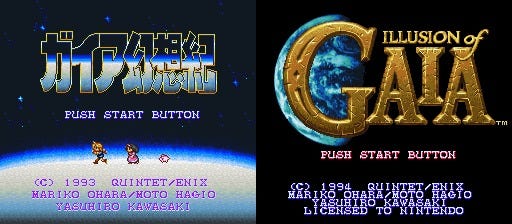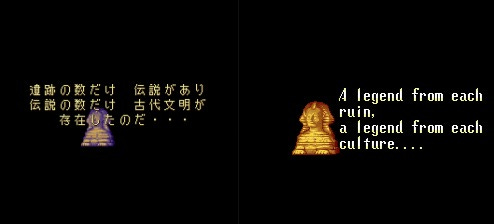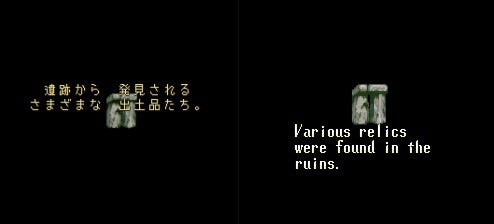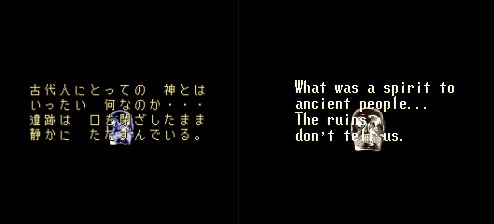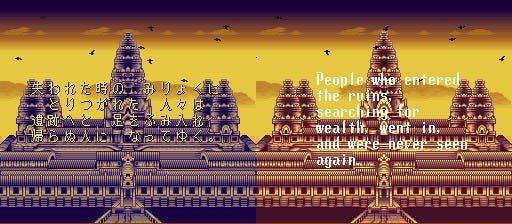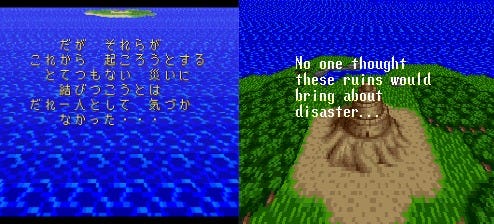Illusion of Gaia Translation commentary Part 1: Attract Screen
I’ve been stuck on exactly how I want to use this blog. Obviously translation mistakes are fun, but they’re also a lot of work for someone who barely speaks Japanese and takes a ton of time to translate sentences.
I tried to use Illusion of Gaia as a learning tool, and made significant progress translating every line, but I got sidetracked from the project. This blog is the perfect motivation to get it back on board.
This will ultimately cover every line I find in Illusion of Gaia, with extra commentary on those I consider mistranslations, poor choices, or interesting for other reasons. I’ll also dig into the JP grammar now and then.
For shorthand from here on:
JP: Japanese text
T: Translation. (Remember, I’m an amateur.)
OE: Original English text
JP: ガイア幻想紀
T: Gaia: Age of Illusion
OE: Illusion of Gaia
The name of the game in EU versions is Illusion of Time. The JP title fits the story best, in my opinion, but they’re all memorable enough. The most important thing is that, in the JP original, the primary protagonists and pig companion are animated running on top of a featureless planet (presumably the comet), but it’s replaced with a static image of Earth in the US version. How boring! We were robbed.
JP: 世界 は 大航海時代の 真っ直中だった。 人々は 新大陸へと 足を のばし 古代文明の遺産を はっくつしていった。
T: The world was in the midst of an age of exploration. People extended their reach to new continents and excavated the heritage of the ancient civilizations.
OE: The world was in an age of exploration. Looking for new lands, man uncovered the relics of ancient cultures.
The original JP says 足をのばし (ashi o nobashi), a verb which means “to stretch one’s legs” or, in a related metaphorical way, to go further somewhere. I chose “extended their reach” but there are numerous options.
JP: はるかなる 時の流れは 数々の伝説を生み出した。
T: As time went on, many legends arose.
OE: As time passed, many legends began to surface.
JP: 遺跡の数だけ 伝説があり 伝説の数だけ 古代文明が 存在したのだ...
T: There were as many ruins as legends, and as many legends as ancient civilizations.
OE: A legend from each ruin, a legend from each culture….
The English snowclone As many X as Y tends to mean “there were numerous X, and therefore numerous Y.” I never thought about it before, but if you look at the phrase literally, it just means “one X for each Y” without implying a large number. The original English is therefore not technically wrong. But I think it misses something. To me, it makes the number of ruins, legends, and civilizations sound very limited.
JP: 遺跡から 発見される さまざまな 出土品たち。
T: Various artifacts are found in the ruins.
OE: Various relics were found in the ruins.
JP: その中には 必ずと言って いいほど 神をかたどった きみょうな石像があった。
T: Among them were strange statues. They were so invariably said to be good that people thought they were effigies of gods.
OE: One of the legends told of strange statues in the shapes of spirits.
We’ve reached our first instance of censorship! That didn’t take long. Nintendo notoriously restricted religious references in games back then, so we’ll be seeing more of this.
Let’s look at this sentence more closely. It’s an interesting one. I split it into two sentences in translation because I think a single English sentence is unwieldy.
その中には (sononakaniwa): As for among which. As in, “speaking of those relics, among them…”
必ずと言って (kanarazutoitte): Always called
いいほど (iihodo): to the point that good
Rearranging, we get “To the point that always called good”. いい is a versatile word that can mean good, excellent, pleasant, cool… lots of positive adjectives available.
神をかたどった (kami o katadotta): made in the shape of gods.
きみょうな (kimyouna): strange
石像があった (sekizouga atta): there were statues.
Rearranging, “there were strange statues made in the shape of gods.”
Now putting it all together: “As for those relics, among them there were strange statues modeled on gods, to the point they were always called good.” Ugh, sounds awful. You can see why I split the sentence into two.
神 (kami) is a difficult word. The original translation uses spirit, which isn’t wrong per se. It’s just that, in English, we mostly think of God or gods as higher beings, and spirits as being common, lower things. Many people believe that souls are spirits, and that we’re all fundamentally made of spirit stuff. But 神 frequently indicates divinity. I think that’s the case here. “Deities” or “gods” would be most appropriate, in my opinion, but no way that would have gotten past Nintendo censors.
There’s also either a minor mistranslation, or an odd translation choice. The original English says that “one of the legends told of” the statues. But the JP refers to the previous sentence in the attract screen, which mentioned relics or artifacts, not legends.
JP: 古代人にとっての 神とは いったい 何なのか... 遺跡は 口を閉ざしたまま 静かに たたずんでいる。
T: What exactly did the gods mean to the ancients? The ruins, standing quietly, tell us not.
OE: What was a spirit to the ancient people… The ruins don’t tell us.
It literally says that the mouths of the ruins are shut silently.
JP: 失われた時の みりょくに とりつかれた 人々は 遺跡へと 足をふみ入れ 帰らぬ人に なってゆく。
T: People who were obsessed with the lost age set foot into the ruins and into their doom.
OE: People who entered the ruins, searching for wealth, went in, and were never seen again.
JP: ある者は財宝を守るための ワナだと 言い また ある者は 古代人の のろいだと 語った。
T: Some said it was due to traps, there to protect treasure; still others said it was a curse of the ancients.
OE: Some said there were traps to protect the treasure, others said it was a curse.
JP: だが それらが これから 起ころうとする とてつもない 災いに 結びつこうとは だれー人として 気づか なかった...
T: Yet, not a single one of them recognized the tremendous disaster that was about to happen…
OE: No one thought these ruins would bring about disaster…
And that’s the attract screen! We’ve hardly stepped into the game at all and I’ve already had a lot to say. More to come.



